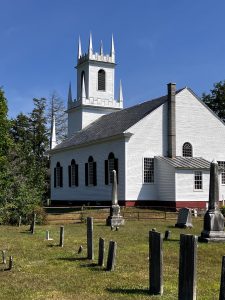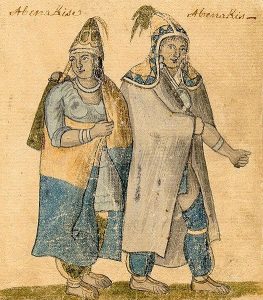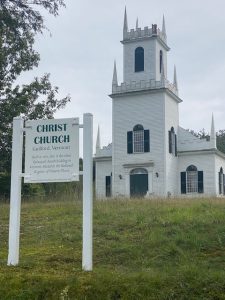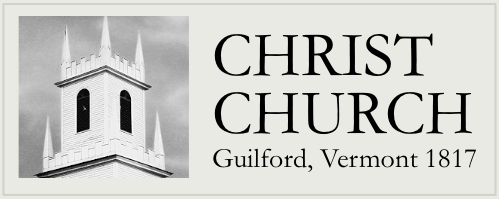In honor of Women’s History Month, here are short biographical sketches of two women associated with Christ Church Guilford about whom we have at least a little information. We celebrate these women in part because their lives have often, sadly, been hidden from our view over the centuries.
Molley (Rice) Gale. Molley/Molly/Mary was a daughter of Micah/Michael and Silence Rice. She was born on September 2, 1761, the first white woman born in Guilford.
Molley married Ephraim Gale about 1780, and, according to Family Search, they had several children: Emory (1784–1864), Artemas/Artemus (1786–1825), Ephraim Jr. (1788–1862), John (1791–1871), Polly (1793–1860), Leonard (1796–1864), Justus (1798–1847), and Clarissa (1803–1874). It was Ephraim (1760-1824) who donated the land on which Christ Church sits, and he, Artemas, John, and Ephraim Jr. donated pews in 1818 to support construction. Molley would have been present during the building of Christ Church and her husband’s and son’s support. She outlived two of her children, died March 19, 1848, at age 87, and is buried in Christ Church Cemetery, along with many other Gale descendants.
Molley, Ephraim and their family – along with many families from the earliest days of Christ Church – would have lived through the formative years of our nation: the Revolution, the first 11 Presidents, the War of 1812, westward expansion, the Louisiana Purchase, and the build-up to the Civil War.  We know too that Native Americans, at least some members of the Abenaki nation, had lived in the area for centuries. The late 18th century, when Christ Church was being founded, was a turbulent time for Native populations, and it was the Abenaki peoples who had been the primary inhabitants of the region. Was there contact between the Gales, other Christ Church congregants, and their Indigenous neighbors, and what might the nature of that contact have been?
We know too that Native Americans, at least some members of the Abenaki nation, had lived in the area for centuries. The late 18th century, when Christ Church was being founded, was a turbulent time for Native populations, and it was the Abenaki peoples who had been the primary inhabitants of the region. Was there contact between the Gales, other Christ Church congregants, and their Indigenous neighbors, and what might the nature of that contact have been?
Furthermore, some of us are familiar with the story of Lucy Terry Prince (1730-1821), “a freed literate and learned African woman, a writer and orator whose legal arguments swayed the Vermont Republic’s highest court. In 1764, Lucy and her husband Abijah, a free black couple, settled in Guilford as one of Guilford’s first landowning settlers. There, they raised six children.” Might Molley, as a child, have known Lucy, who was approximately 30 years her senior? What an intriguing and provocative notion!
Hannah (Palmer) Gregory. In July 2023, Christ Church Guilford received a donation from Morris and Sandy Gregory, who are descended from Stephen and Hannah Gregory. Morris and Sandy report that they have sat in the pews that bear Stephen and Hannah’s names, Stephen appearing on the list of those who donated a pew in 1818. Hannah Childs Palmer was one of nine children of Humphrey Palmer and Marcy (or Mercy) Bacon, born June 22, 1784, in Guilford. She married Capt. Stephen Gregory on February 8, 1808.
According to Family Search, Hannah and Stephen (1780-1845) had eight children: John Stanford (1808–1886), George H. (1810–1877), Dr Samuel (1813–1872), Mary (1815–1865), Stephen Jr (1818–1863), Daniel Lawrence (1821–1854), Ellen (1823–1895) and Edward Palmer (1826–1902). Two of Hannah’s children predeceased her. She died May 10, 1864. Both she and Stephen are buried in Christ Church Cemetery.
To raise children in the early 19th century meant, among other things, feeding, cleaning and medical care for everyone in the household, as well as supervising any servants.  Such a woman (often pregnant, of course) would also be in charge of the various buildings in and around the home, making food and drink, caring for animals, creating clothing and candles, tending gardens, and assisting with gathering crops at harvest time. It was probably the man of the house who tended to other livestock and dogs – until, in many cases, the husband/father went off to war, died or became disabled. Mothers, furthermore, were responsible for their offspring’s spiritual and civic education. We hope that the women of Guilford were well-treated by their husbands – and we have no reason to think otherwise – but we know that domestic violence was not an unheard-of situation.
Such a woman (often pregnant, of course) would also be in charge of the various buildings in and around the home, making food and drink, caring for animals, creating clothing and candles, tending gardens, and assisting with gathering crops at harvest time. It was probably the man of the house who tended to other livestock and dogs – until, in many cases, the husband/father went off to war, died or became disabled. Mothers, furthermore, were responsible for their offspring’s spiritual and civic education. We hope that the women of Guilford were well-treated by their husbands – and we have no reason to think otherwise – but we know that domestic violence was not an unheard-of situation.

Conclusion
Obviously there are many more women who have been associated with Christ Church Guilford, both in the past and today. There are also women who have contributed to the town of Guilford in general, some of whom are noted in the exhibits and archives of the Guilford Historical Society. We salute and thank them!
Resource
Hemenway, Abby Maria, ed. Vermont Historical Gazetteer, a local History of all the Towns in the State: Civil, Educational, Biographical, Religious and Military, Vol. V, The Towns of Windham County. Brandon, VT: 1891.
Valerie Abrahamsen, ThD
